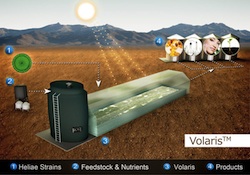Heliae has revealed its latest microalgae production platform, Volaris, the result of five years of research and development. The technology was designed to produce high purity microalgae at competitive prices. According to the company, Volaris will enable large-scale production for diverse markets and provide a natural, sustainable and consistent supply of alage-based products to meet worldwide demand.
“Good science takes time,” said Dan Simon, Heliae’s president and CEO. “We’ve developed a technology platform that finally delivers on what the industry has been promising for more than a decade. With Volaris technology, we’re now able to offer algae solutions for a range of markets, which have not been possible with existing technology. This technology will unlock the industry.”
 Volaris combines the best of existing algae production pathways, utilizing both sunlight and waste carbon feedstocks to optimize facility economics according to Lee Tonkovich, Heliae’s vice president of research and development. “The algae industry has been hindered by the limits of conventional technology. Phototrophy and heterotrophy, both have their weaknesses – namely contamination and low growth rates in phototrophy and extremely high capital and operating expenses in heterotrophy.”
Volaris combines the best of existing algae production pathways, utilizing both sunlight and waste carbon feedstocks to optimize facility economics according to Lee Tonkovich, Heliae’s vice president of research and development. “The algae industry has been hindered by the limits of conventional technology. Phototrophy and heterotrophy, both have their weaknesses – namely contamination and low growth rates in phototrophy and extremely high capital and operating expenses in heterotrophy.”
Tonkovich continued, “We’ve developed a hybrid mixotrophic pathway which drives down capital costs, reduces contamination, and increases productivity to dramatically improve the economics of algae production. The productivity gains Volaris provides will reduce much of the land required for a commercial facility.”
Volaris will play an important role in Heliae’s new 20-acre commercial facility currently under construction in Gilbert, Ariz., slated to open in late Q3 of 2013.
“Volaris is the next generation in algae growth technology,” added Adrian Galvez, vice president of operations for Heliae. “With it, we can drop the dollar per kilogram cost to a point that makes algae immediately attractive. The flexibility we have in this technology allows us to control output traits and deliver exactly what a customer needs from our algae. This increased product optionality will open new markets for algae.”

